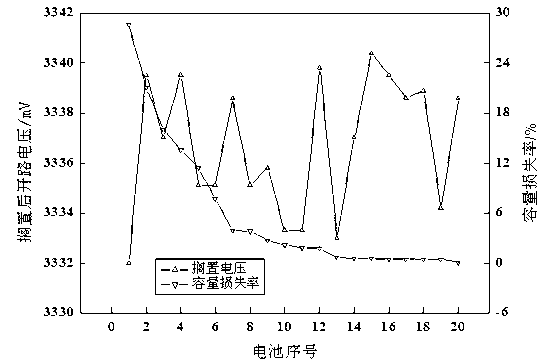Method for quickly and effectively comparing self-discharge rates of batteries
A self-discharge rate, battery technology, applied in the direction of measuring electricity, measuring electrical variables, measuring devices, etc., can solve the problems of high price, long measurement period, short test period, etc., to achieve the effect of improving effectiveness and high selection efficiency
- Summary
- Abstract
- Description
- Claims
- Application Information
AI Technical Summary
Problems solved by technology
Method used
Image
Examples
Embodiment Construction
[0016] Below in conjunction with accompanying drawing and specific embodiment, further illustrate the present invention, should be understood that these embodiments are only for illustrating the present invention and are not intended to limit the scope of the present invention, after having read the present invention, those skilled in the art will understand various aspects of the present invention Modifications in equivalent forms all fall within the scope defined by the appended claims of this application.
[0017] see figure 1 , figure 2 and image 3 As shown, the method for quickly and effectively comparing the size of the battery self-discharge rate of the present invention comprises the following steps:
[0018] 1) When the battery is fully charged normally, continue to charge the battery with constant voltage and current limitation until the charging current drops to an extremely low state or stops charging when the current value fluctuates up and down for a long tim...
PUM
 Login to View More
Login to View More Abstract
Description
Claims
Application Information
 Login to View More
Login to View More - R&D
- Intellectual Property
- Life Sciences
- Materials
- Tech Scout
- Unparalleled Data Quality
- Higher Quality Content
- 60% Fewer Hallucinations
Browse by: Latest US Patents, China's latest patents, Technical Efficacy Thesaurus, Application Domain, Technology Topic, Popular Technical Reports.
© 2025 PatSnap. All rights reserved.Legal|Privacy policy|Modern Slavery Act Transparency Statement|Sitemap|About US| Contact US: help@patsnap.com



